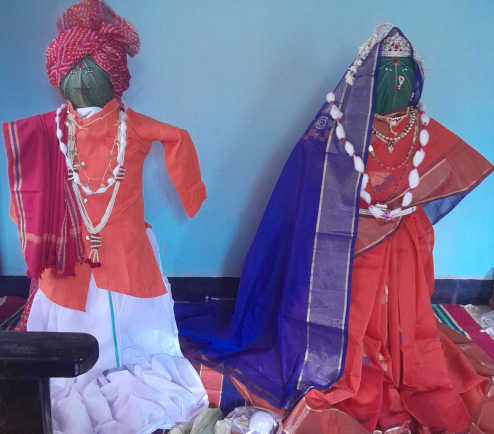श्री Yogesh Ashok Powar
Personal Blogs
Ganapati
Ganapati Bappa Moraya
Tags: Ganapati UtsavGanapati Bappa Moraya
As the Ganesh festival concluding, Lord Ganesh, fondly known as Bappa, blesses his devotees by helping them transcend their tamasic (inert) tendencies and elevates them to a higher level of consciousness.
As a family deity
People from cities often take 5-7 days off, working hard in the weeks prior to the festival to make time for travel. They commute to their hometowns, spending time with family and friends, engaging in a mix of fun, adjustments, celebrations, decorations, pujas, and archana, all culminating with Bappa’s visarjan (immersion ceremony).
In the image above are Gauri and Shankar, made from grass, leaves, and plants with medicinal properties. Ganapati comes to his maternal home, followed by Gauri (Parvati), his mother, and then comes Shankar (Mahadev), his father. Each arrival brings joy and celebration to the family.
As Sarvajanik Utsav
This weekend, our society too organized several events, and I’ll highlight some suggestions for improving event management next time.
Sports & Draws
In some sports matches, boys and girls played together or due to an odd number of participants, some players were automatically promoted to the next round, even as late as the quarterfinals.
I had to request the management to help me contributing in streamlining the process for the next batches. In fact, Organizing a draw is more challenging than it appears, as I realized while doing it myself.
The draws should be based not only on the order of registration but also on the skill level of the players. Otherwise, the game becomes a matter of luck, as top players might face each other in the very first round. An approximate ranking of players/teams is mandatory before planning the draws to ensure fairness. Ideally, the strongest four should not meet until the semifinals.
A practical challenge often arises in spontaneous events, especially with odd or late participants. For example, we recently had 23 participants and decided on doubles matches due to time constraints. While the first round was in progress, we reserved a slot for the 24th participant but ended up receiving three more participants.
For larger groups, the draw planning should follow a top-down approach, dividing participants into four subgroups, with each subgroup winner advancing to the semifinals and then to the finals.
In contrast, for smaller groups, this isolation method may not be suitable. In one case, we had only five entries. We organized qualifying rounds to eliminate two teams, leaving three. The remaining three teams played a round-robin, where the winner of the first match went directly to the finals. The losing team faced the third team, with the winner advancing to the finals and the loser securing the bronze medal.
Managing last-minute entries and scheduling matches on the fly was a challenge, but it was enjoyable nonetheless.
We also organized some short-distance sprints (70 meters) for kids. One improvement I suggested was capturing video at the finish line, rather than from a distance and an angle, which distorts the results. Being directly on the finish line provides a clear and fair perspective.
Dance & Art
The art performances were a delight, with impressive acts by individuals and teams. Some participants choreographed their own routines, while others sought professional help. A great deal of effort goes into selecting the perfect song, editing it to match the flow of the performance, shopping for outfits, accessories, and makeup—truly a labor of love that consumes a lot of energy.
However, when judges evaluate performances solely from their own perspective, often without considering the personal backgrounds and efforts of the participants, it can lead to unfair outcomes. This can unintentionally shift the focus from the joy of performing and appreciating the art form to merely winning, which can demotivate participants.
Suggestions
- Since the goal is to promote participation, efforts should be recognized and rewarded. Simple rewards, like notebooks or pencils for all volunteers and participants, would be more meaningful than only awarding trophies to three winners.
- Events should emphasize giving individuals multiple opportunities to participate and enjoy the activities, rather than eliminating participants quickly and reducing their chances.
- Instead of trying to fit many activities into a single week, why not spread them out throughout the year, or organize them on occasions like 15th August, 26th January, or even during festivals like Kojagiri, Narali Purnima, or Navratri?
- We often see the same people involved everywhere. It’s high time we bring younger members into the management committee.
- For events like this, we spend a lot on temporary infrastructure that doesn’t last beyond the event. Along with the temporary setup, as a community, we should also focus on building something permanent or long-lasting. For example, the place where we immerse the idol doesn’t have proper steps, and the area is often unclean. After showing devotion to the deity for days, it’s disheartening that the final immersion takes place in such a shabby environment.
In my opinion, the real purpose of the सार्वजनिक गणेश उत्सव is not to identify winners, but to encourage participation from all members of society, fostering community unity. It’s a chance to bring everyone together, and in doing so, we experience Bappa’s blessings by recognizing his presence within each one of us.
गणपती बाप्पा मोरया, पुढच्या वर्षी लवकर या!
Tags: Ganapati Utsav
Updated on: 2024-09-15


